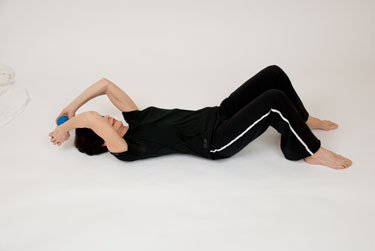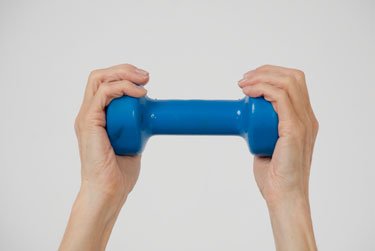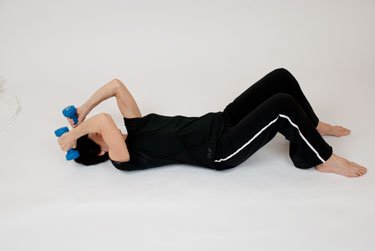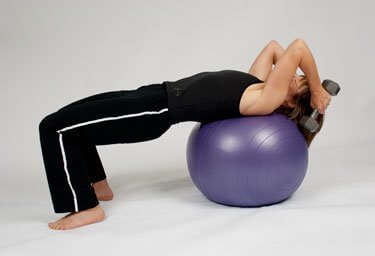Table of Contents
In this blog, I will demonstrate several variations of the tricep extensions exercise, including the supine tricep press. Each of these is part of the Exercise for Better Bones program and progressively more difficult.
Tricep Extensions
The five tricep extensions variations are:
- Supine Tricep Extension for Beginner
- Supine Tricep Extension for Active
- Stability Ball Tricep Extension for Athletic
- Stability Ball Tricep Extension for Elite • Position A
- One Arm Tricep Extension on Stability Ball for Elite • Position B
Let’s start with the Supine Tricep Extension for Beginner.
Supine Tricep Press Extension • Beginner
The Supine Tricep Press Extension (or Tricep Extension from Floor) is one of the Beginner level osteoporosis strength exercises found in the Exercise for Better Bones program.
Instructions
Follow these instructions to do the supine tricep extension for beginner level.
I encourage you to invest in weight training gloves or a pair of biking gloves because your weights are over your head and you want to ensure maximum grip.
Also safety is important.

- You want to grasp the weight with your top arm.
- Bring it towards your chest and roll over with it here.
- You want to keep your feet and knees hip-width apart.
- Share the weight, so one hand on each side of the dumbbell.
- Raise the dumbbell up over your forehead.
- Lower the weight down and rest behind your head.
- Take a breath in.
- Slowly, gently keep your tummy tight as you let the weight come behind your head, elbows are pointing to the ceiling, and then straighten the arms.
- Breath in.
- Tummy tight as you lower and straighten.
When you’ve done your set, the weight comes back to rest on your chest, and then roll onto your side to bring it safely.

Supine Tricep Press Extension • Active
The supine tricep press extension (tricep extension on the floor) is a weight bearing exercise from Exercise for Better Bones. It targets at the triceps, shoulder muscles and the wrists.
Instructions
Follow these instructions to do the supine tricep extension for active level.
- Let’s focus on safety.
- You first want to grab, with your top arm, the first dumbbell, pass it to your bottom arm.
- Then you grab the second dumbbell, and in this position, roll onto your back.
- Your feet and your knees are going to be hip-width apart.
- You’re going to bring both dumbbells straight up over your forehead, and once you’re comfortable in this position, you’re going to split the weights so each hand and each shoulder is holding individual weights and responsible for each of them.
- Now, in this position, you now take your breath in, keep your tummy muscles tight as you lower the weight so that you’re not arching your back, and back up.
- Breath in, tummy muscles tight as you lower and straighten the weight.
- Rest the the weight on either side of your head, and back up.
- When you’re done your set, bring your weights back to rest on your chest, roll onto your side, drop your top arm weight first.
- Grasp it with the top arm, and then let go of the other one. Doing this motion with the weight can hurt some people’s shoulders, so it’s best not to take a chance.

Exercise Recommendations for Osteoporosis
Exercise is an essential ingredient to bone health. If you have osteoporosis, therapeutic exercise needs to be part of your osteoporosis treatment program.
But what exercises should you do and which ones should you avoid? What exercises build bone and which ones reduce your chance of a fracture? Is Yoga good for your bones? Who should you trust when it comes to exercises for osteoporosis?
A great resource on exercise and osteoporosis is my free, seven day email course called Exercise Recommendations for Osteoporosis. After you provide your email address, you will receive seven consecutive online educational videos on bone health — one lesson each day. You can look at the videos at anytime and as often as you like.

I cover important topics related to osteoporosis exercise including:
- Can exercise reverse osteoporosis?
- Stop the stoop — how to avoid kyphosis and rounded shoulders.
- Key components of an osteoporosis exercise program.
- Key principles of bone building.
- Exercises you should avoid if you have osteoporosis.
- Yoga and osteoporosis — should you practice yoga if you have osteoporosis?
- Core strength and osteoporosis — why is core strength important if you have osteoporosis?
Enter your email address and I will start you on this free course. I do not SPAM or share your email address (or any information) with third parties. You can unsubscribe from my mail list at any time.
Stability Ball Tricep Extension • Athletic
The Stability Ball Tricep Extension (also called the Tricep Extensions on Ball) exercise is an Athletic level strength exercise from the Exercise for Better Bones Program. This exercise is designed to target the muscles in triceps, shoulders, buttocks, and hamstrings. It is also designed to challenge the bones in the wrists, hips and spine. in the video, I demonstrate this exercise.
Instructions
Follow these instructions to do the stability ball tricep extension (position A) for elite level.
You will use two dumbbells this time.
- If you have gloves, this is a good time to put them on.
- Let the weight rest on your chest or on your hips, whichever you’re most comfortable with.
- The heavier the weights, the easier it is to hold it at the hips.
- Bring yourself down, following the ball straight down.
- Then hips come up.
- The weight is going to come straight up over your head.
- This is where you split the weight.
- Hips nice and high. Feet hip width apart.
- Weight comes just behind each ear and fully extend it.

Finish Set Safely
- Once you finish your set, drop the weight back down.
- Drop your hips.
- Now this is where you bring the weights on either side of you.
- Ensure that when you do that, your hips are down so your arm is in the same plane as your body and you’re not putting any stress on your shoulders.
- Clear the weights from your path and come on up and keep a nice, tall posture.
One Arm Tricep Extension on Stability Ball • Elite • Position B
The Stability Ball Tricep Extension (also called the Tricep Extensions on Ball or One Arm Tricep Extension) Position B is a strength exercise from the Exercise for Better Bones program specifically designed for the Elite Level. The exercise targets the muscles of the triceps, shoulders, buttocks and hamstrings. It also targets the bones in the wrists, hips and spine.
Instructions
Follow these instructions to do the stability ball tricep extension (position B) (one arm tricep extension for elite level).
- You’re going to start with your thumb pointing to the opposite shoulder.
- The weight that you’re not using is sitting on the opposite hip, giving you a little extra resistance in your glutes and back extensors.
- You’re going to slowly bring the weight down and back up.
- The weight should not rest on the opposite shoulder, but rather just lightly come in contact with it.
- When you’re doing your set, putt the weight back down and switch to the other side.
- Again, thumb points to the opposite shoulder and back up.
- Thumb down to the opposite shoulder and up.
Osteoporosis Exercise Plan
Visit my Osteoporosis Exercise Plan page for more information on this topic.

Comments
February 19, 2019 at 12:32pm
Susan Gardner
How much weight do you recommend using?
February 20, 2019 at 3:06pm
Richard Martin replies
Hi Susan, If you have never done a tricep strengthening exercise before, I would recommend you start light such as 2 pounds shared between both hands. If you can easily do 15 repetitions at a pace of 2 seconds lowering and 2 seconds lifting with a second pause above the floor and at the top then you should progress to 3 pounds....keep increasing the weight every other or third day until you are challenged to reach 15 repetitions. As long as you feel you have a good grip on the weight and you can keep an even pace and good form then you can keep challenging yourself.
In the first two weeks 1 set of 15 reps, done 2 - 3 X/week is plenty. After which you can add second set... and two weeks later a third set. But more important than increasing the number of sets is being consistent with at least one or two sets. You will be surprised how you will quickly tone up your arms (in time for sprinG!) and how daily activities such as pushing open a door will begin to feel easier. All the best!
February 19, 2019 at 8:45pm
Kate Alexander
For a beginner, how much weight and how many reps?
February 20, 2019 at 3:08pm
Richard Martin replies
Hi Kate,
Hi Susan, I did not want you to feel I was just copying and pasting an answer but what I wrote for Susan holds for you:
If you have never done a tricep strengthening exercise before, I would recommend you start light such as 2 pounds shared between both hands. If you can easily do 15 repetitions at a pace of 2 seconds lowering and 2 seconds lifting with a second pause above the floor and at the top then you should progress to 3 pounds....keep increasing the weight every other or third day until you are challenged to reach 15 repetitions. As long as you feel you have a good grip on the weight and you can keep an even pace and good form then you can keep challenging yourself.
In the first two weeks 1 set of 15 reps, done 2 - 3 X/week is plenty. After which you can add second set... and two weeks later a third set. But more important than increasing the number of sets is being consistent with at least one or two sets. You will be surprised how you will quickly tone up your arms (in time for sprinG!) and how daily activities such as pushing open a door will begin to feel easier. All the best!
February 19, 2019 at 9:09pm
Satish Thakrar
Thanks, Margaret. I will need to adjust my tricep extension exercise. -Satish
February 20, 2019 at 3:09pm
Richard Martin replies
Hi Satish,
I'll look forward to seeing you in the springtime. It will be time to come in for a refresher of your exercises or a review of your form. Hope you are enjoying your retirement. Keep well,
Margaret
February 20, 2019 at 5:49pm
Diana Mackenzie
Thank you for this invaluable information. I have progressed to 3kg in each hand, but am cautious about increasing above this weight as I have hypermobility and don't want to strain anything. To put maximum stress on my bones I understand I should continue to increase the weight. What happens when you reach your optimum weight, do you just keep working at that weight, as surely that won't stress the bones after a while?
February 26, 2019 at 8:29pm
Georgette
Hello. Can you recommend a knowledgeable Physical Therapist in San Francisco? I'm 59 years old and have severe osteoporosis. T score is -5.9. Three years ago I had a compression fracture at T7. I have intense upper back and wrap around rib pain constantly. I've seen several therapists which resulted in an increase of pain. I have been unable to locate anyone with your expertise. Any suggestions would be appreciated. Thank you.
February 27, 2019 at 3:16pm
Richard Martin replies
Hi Georgette, Thank you for contacting me. You are lucky to live in SF because one of the best Physical Therapists in the area of osteoporosis works at SFU: https://ptrehab.ucsf.edu/wendy-katzman-pt-dptsc-ocs
Please give her my regards.
All the best,
Margaret
March 1, 2019 at 4:25pm
Alejandro L Franco
Hi, I have osteoporosis, I've had 3 fractured vertebrae, I also have constant low back pain and rib pain. I also have Multiple Myeloma. Could you recommend a physical therapist in the Los Angeles area, preferably the San Gabriel area. I would really appreciate it